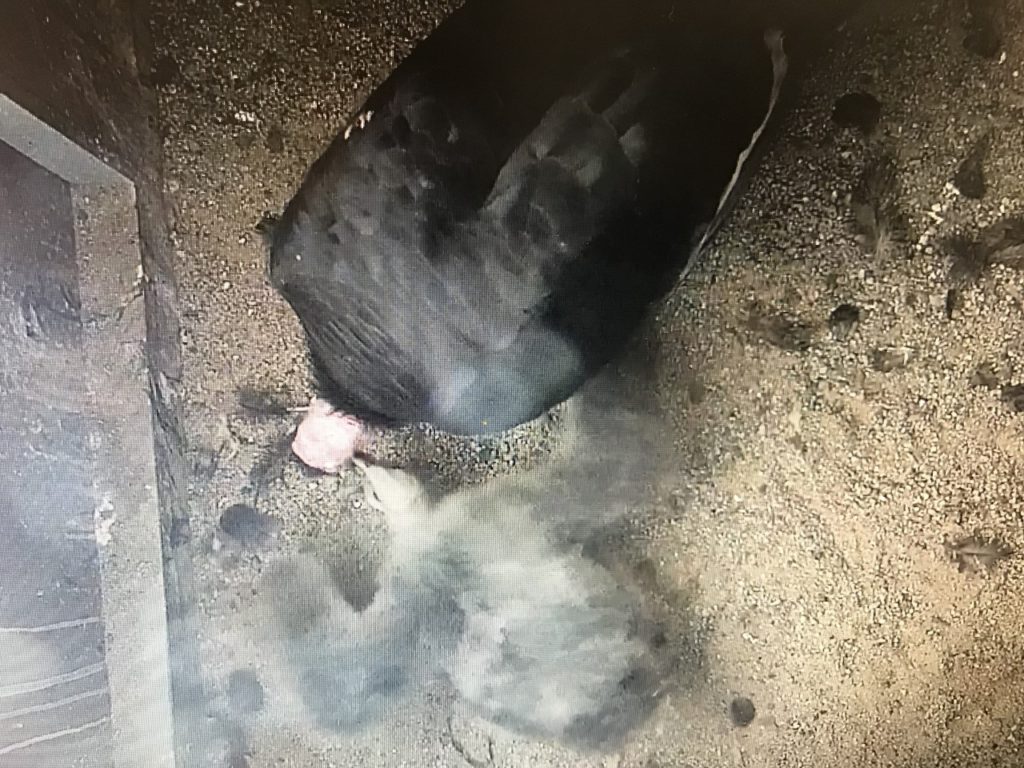
On Monday, July 1, our California condor chick, named Luhui (pronounced “loo-HOO-wee”), received its first health exam. We normally conduct this exam at around 45 days of age. The goal was to obtain a blood sample for our labs, administer a vaccine for West Nile virus, inject a microchip for identification, and weigh the chick.
The first step in this process is to separate the parents from the chick. Of course, the parents—father Siwon and mother Sola—don’t want any invaders in the nest and do their best to defend the chick and keep it safe, as all good parents will do. We have the ability to use a sliding door to close off the nest from the flight pen. As long as Siwon and Sola don’t see anyone enter their nest, they stay relatively calm, so we enter the nest from a back access door, where the parents can’t see us.
Once in the nest, we covered the little chick with a towel. This was the first time that the 46-day-old chick had ever seen a person, and was understandably nervous and defensive, hissing and lunging at the intruder. While under the cover of the towel, the chick could not see and calmed down. It was then brought downstairs to our keeper area where our veterinary staff was waiting.
First, the veterinarian obtained a blood sample from the chick’s leg. This sample will be sent to the lab to make sure that the chick is healthy. Also, our geneticists at the San Diego Zoo Institute for Conservation Research can determine if it is male or female from this sample. We should hopefully get the results soon.
Next, a vaccine for West Nile virus was administered. West Nile virus is a disease that originated in Africa and was accidentally introduced to North America by humans. North American animals, including condors, usually don’t have a natural immune response to West Nile Virus, so we are trying to give the chicks as much of a head start as we can.
Then a microchip was injected under the chick’s skin. This chip is a form of identification. It’s the same kind of chip you can get for your dog or cat at the veterinarian.
The veterinarian then gave a quick health assessment, checking the chick’s eyes, nares (nostrils), beak, feet, legs, wings, and abdomen.
Lastly, we weighed the chick to make sure it was growing on schedule.
The whole exam, from capture to release, took approximately 11 minutes. Once the exam was over, Luhui was returned to the nest. Siwon and Sola checked on their baby several hours later.

As previously mentioned, the chick was rightfully disturbed by this process, despite our best intentions to minimize stress. Although we feel bad that the chick was so nervous, it is actually good that it was not comfortable in our presence. We have to keep in mind that we don’t want the young condor to become accustomed to or feel reassured by humans; we want it to be a wild condor, uninterested and wary of humans, so that it may someday fly free in California, Arizona, or Mexico. Condors that show an affinity for humans seldom survive in the wild.
So far, the health exam looks to have been successful. Hopefully, the bloodwork will show that the chick is healthy. The veterinarian’s initial inspection looked great; the chick’s eyes and nares were clear, the feet, legs and wings were solid, and vitality was very strong. The chick weighed 7 pounds (3.2 kilograms) and was approximately the size of a bowling ball. We hope to receive the sex results from the Conservation Genetics Lab soon. When we do, we’ll let you know if Luhui is a male or a female.
Ron Webb is a senior keeper at the San Diego Zoo Safari Park. Read his previous blog, California Condor Chick Watching: 30 to 45 Days of Age.



